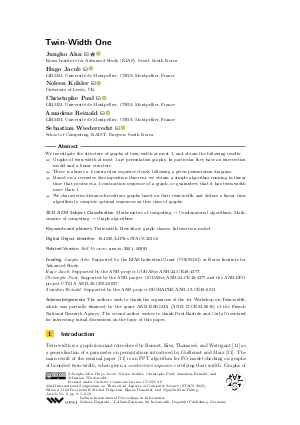LIPIcs.STACS.2025.6.pdf
- Filesize: 0.87 MB
- 19 pages

 Creative Commons Attribution 4.0 International license
Creative Commons Attribution 4.0 International license

We investigate the structure of graphs of twin-width at most 1, and obtain the following results: - Graphs of twin-width at most 1 are permutation graphs. In particular they have an intersection model and a linear structure. - There is always a 1-contraction sequence closely following a given permutation diagram. - Based on a recursive decomposition theorem, we obtain a simple algorithm running in linear time that produces a 1-contraction sequence of a graph, or guarantees that it has twin-width more than 1. - We characterise distance-hereditary graphs based on their twin-width and deduce a linear time algorithm to compute optimal sequences on this class of graphs.




Feedback for Dagstuhl Publishing